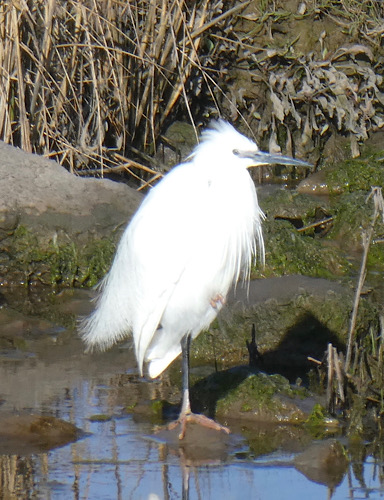The cold NW winds eased a bit more. A clear start clouding over by lunch, but it remained dry.
South shore
Shelduck 61
GreyPlover 1
Wheatear 2
Rock pipits 3 (1 Red Nab, the ringed male on mid point of harbour wall and 1 near waterfall)
Grey Seal 1 quite distant near No.1 outflow
 |
| The dried mud on this Little Egret's feet make them look pink. More on Little Egrets later. |
This Chiffchaff was feeding near the small anemometer, and seemed to be catching lots of small insects.
North shore
Pete and Jean had a "dire" 1.5hr morning sea watch resulting in just:
Red-Throated diver 1 distantly on the sea out from Knowlys
Bar-Tailed Godwit 1 on Near Naze
Heysham skeer - Low water 16:00
Eider at least 70
No Red-breasted Merganser or Great Crested grebe seen
No Knot either, but at least 250 Turnstone.
This clip may explain why the Turnstones have taken to feeding on the skeer in large numbers. These are two Turnstone and a Dunlin feeding. Watch the Turnstone on the left - it's catching honeycomb worms!
This is the first time I've seen anything eat the honeycomb worms. This Turnstone makes it look easy, you'd think the other waders would also take advantage. These are the honeycomb worm beds on the southern edge of the skeer, which take the brunt of the storms and so regularly reform. This area is recently formed, so not as high and dense as the beds on the north side. The worms do not get much bigger than these, even when the tubes are 2m high! This was the only Dunlin I saw, it seemed to try and copy the Turnstones.
 |
| Two Lesser Black-Backed gulls taking a break. |
On Saturday Pete counted 13 Little Egret and commented that it seemed a large gathering at breeding season. Today there was only 5, but you can see the attraction, this one catches 4 Common Goby in the duration of this clip.
The west wind colours the shallow water, which in turn brings the gobies closer in than they would normally venture.
Behind the Egret you can see the Turnstone waiting on the Honeycomb worm beds. This was more or less low water, they didn't start feeding on the worms till the tide started rising. That must be the key! Presumably the worm stays at the bottom of its tube until the tide rises and then it moves up to feed. If so, it's only a short window of opportunity before the tubes are covered. I'll check in more detail next visit.
(Can't wait! I love something new to try and understand.(MD))